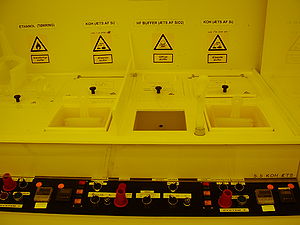Specific Process Knowledge/Etch/KOH Etch: Difference between revisions
| Line 3: | Line 3: | ||
KOH belongs to the family of anisotropic Si-etchants based on aqueous alkaline solutions. The anisotropy stems from the different etch rates in different crystal directions. The {111}-planes are almost inert whereas the etch rates of e.g. {100}- and {110}-planes are several orders of magnitude faster. | KOH belongs to the family of anisotropic Si-etchants based on aqueous alkaline solutions. The anisotropy stems from the different etch rates in different crystal directions. The {111}-planes are almost inert whereas the etch rates of e.g. {100}- and {110}-planes are several orders of magnitude faster. | ||
At Danchip we use as a standard a 28 wt% KOH. | At Danchip we use as a standard a 28 wt% KOH. The etch rate - and the selectivity towards a SiO2-mask - is depending on the temperature. We normally use T=80 <sup>o</sup>C but may choose to reduce this to e.g. 60 <sup>o</sup>C or 70 <sup>o</sup>C in case of a high-precission timed etch (e.g. defining a thin membrane). In some cases we recommend to saturate the standard 28 wt%KOH with IPA with T=70 <sup>o</sup>C (reduce evaporation of IPA). One example is for boron etch-stop, where the selectivity towards the boron-doped silicon is improved. | ||
<br clear="all" /> | <br clear="all" /> | ||
Revision as of 11:17, 28 January 2008
KOH etch - Anisotropic silicon etch

KOH belongs to the family of anisotropic Si-etchants based on aqueous alkaline solutions. The anisotropy stems from the different etch rates in different crystal directions. The {111}-planes are almost inert whereas the etch rates of e.g. {100}- and {110}-planes are several orders of magnitude faster.
At Danchip we use as a standard a 28 wt% KOH. The etch rate - and the selectivity towards a SiO2-mask - is depending on the temperature. We normally use T=80 oC but may choose to reduce this to e.g. 60 oC or 70 oC in case of a high-precission timed etch (e.g. defining a thin membrane). In some cases we recommend to saturate the standard 28 wt%KOH with IPA with T=70 oC (reduce evaporation of IPA). One example is for boron etch-stop, where the selectivity towards the boron-doped silicon is improved.
Comparing the two solutions
| Aluminium Etch 1 | Aluminium Etch 2 | |
|---|---|---|
| General description |
Etch of pure aluminium |
Etch of aluminium + 1.5% Si |
| Chemical solution | HO:HPO 1:2 | PES 77-19-04 |
| Process temperature | 50 oC | 20 oC |
| Possible masking materials: |
Photoresist (1.5 µm AZ5214E) |
Photoresist (1.5 µm AZ5214E) |
| Etch rate |
~100 nm/min (Pure Al) |
~60(??) nm/min |
| Batch size |
1-25 wafers at a time |
1-25 wafer at a time |
| Size of substrate |
4" wafers |
4" wafers |
| Allowed materials |
|
|
